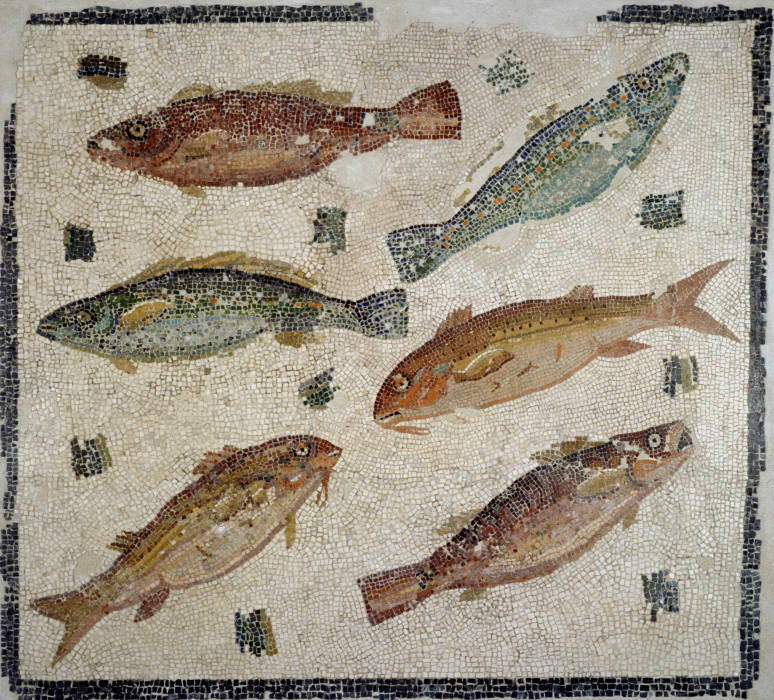At The Fishmonger in Italy Posted by Serena on Dec 2, 2016 in Italian Language
Have ever tried to buy fish in Italy? Here’s an opportunity for you to work on your fish shopping vocabulary.
The setting
la pescheria del nostro amico Beppe (our friend Beppe’s fishmonger’s)
The characters
Serena, Geoff, Beppe il pescivendolo e sua moglie Gabriella (Serena, Geoff, Beppe the fishmonger and Gabriella, his wife)
Serena e Geoff: “Salve, buongiorno a tutti!”
Serena and Geoff: “Hello, good morning everyone!”
Gabriella: “Buongiorno!” e continua a servire un altro cliente
Gabriella: “Good morning!” continuing to serve another customer
Beppe: “Buongiorno ragazzi, come va?”
Beppe: “Good morning guys, how are things?”
Geoff: “Non c’è male, e voi?”
Geoff: “Not too bad, and what about you?”
Beppe: “Bene, grazie! Qual buon vento vi porta?“
Beppe: “Fine, thanks! What (good wind) brings you here?”
Serena: “Vorrei fare il salmone al cartoccio, ma c’è anche Geoff a pranzo, e lui guai se vede una spina”
Serena: “I’d like to make baked salmon, but Geoff’s having lunch with us too, and it’s bad news if he sees a fish bone”
Geoff: “Se sento una spina in bocca mi viene subito da vomitare, è più forte di me”
Geoff: “If feel a bone in my mouth I immediately feel like vomiting, I can’t help it”
Beppe: “Ti faccio dei filetti di salmone, così le spine si eliminano più facilmente”
Beppe: “I’ll make you some salmon fillets, so it’s easier to eliminate the bones”
Geoff: “Perché non prendiamo la sogliola? Quella mi piace di sicuro”
Geoff: “Why don’t we get the sole? I’m sure I like that”
Serena: “La sogliola costa molto di più. La prendiamo la prossima volta quando siamo solo noi due“
Serena: “Sole is much more expensive. We’ll get it next time when it’s just us two”
Beppe: “Allora ti faccio i filetti di salmone?”
Beppe: “So shall I prepare you the salmon fillets?”
Serena: “Sì, grazie”
Serena: “Yes please”
Beppe taglia la testa al salmone, poi appoggia il coltellone sul corpo del pesce e chiede: “Quanto? Così va bene?”
Beppe cuts off the salmon’s head, then positions the big knife on the fish’s body and asks:” How much? Is this OK?”
Serena: “Appena un pochino di più, siamo in tre … ecco, così va bene”
Serena: “Just a little bit more, there are three of us … yes, it’s fine like that”
Beppe taglia deciso, poi comincia a pulirlo con maestria: prima lo spella, poi ne fa dei filetti e infine lo spina. Geoff non osa guardare, gli fa ribrezzo.
Beppe cuts decisively, then skilfully starts to clean it: first he skins it, then makes fillets out of it, and finally removes the bones. Geoff dare not look, the sight makes him shudder.
Beppe: “Altro?”
Beppe: “Anything else?”
Serena: “Sì, vorrei dei gamberetti per un risotto”
Serena: “Yes, I’d like some shrimps for a risotto”
Beppe: “Quanti?”
Beppe: “How many?”
Serena: “Abbastanza per tre persone”
Serena: “Enough for three people”
Beppe: “Ecco qui. Te li pulisco?”
Beppe: “Here they are. Shall I clean them?”
Serena: “Sì grazie”
Serena: “Yes, please”
Beppe velocissimo gli stacca la testa e la coda, li sguscia e poi ci sfila quella righina nera che corre lungo la sommità. “Ce la tolgo sennò può capitare che mentre li mangi senti dei pezzetti di conchiglia o di sabbia sotto ai denti” spiega Beppe. “A posto così?” chiede
Beppe quickly starts pulling their heads and tails off, ‘shells’ them, then slips off that thin black line that runs along the top. “I’m removing it because if I don’t you might find that while you are eating them you feel bits of shells or some sand between your teeth” he explains. “Will that be all?” he asks
Serena: “Sì, a posto così. Quant’è?”
Serena: “Yes, that’s all. How much is it?”
Beppe: “Diciassette euro e trenta”
Beppe: “Seventeen Euros thirty”
Serena: “Diciassette e trenta … vediamo se ce li ho spiccioli … ecco qui … precisi!”
Serena: “Seventeen thirty … let’s see if I have the change … here it is … exactly!”
Beppe: “Perfetto, grazie e arrivederci!”
Beppe: “Perfect, thanks and see you soon!”
Serena e Geoff: “Ciao e grazie!”
Serena and Geoff: “Bye and thank you!”

Build vocabulary, practice pronunciation, and more with Transparent Language Online. Available anytime, anywhere, on any device.





Comments:
Laurel Barton:
The Italian use of plurals for mass nouns is a tough thing to learn. In effect, “shrimps” not shrimp, “sands” not sand. Likewise it is hard for an Italian to use mass nouns in English, in my experience.
Bahia Philpot:
@Laurel Barton Hi Laurel, surely gamberetti is the pluriel of gamberetto!
paolo minotto:
Ciao Geoff/ Serena,
“…e lui guai se vede una spina”
Non capisco la parola “guai”. Sembra che sia derivato dal verbo “guaire” ma sarebbe ” guaisce” in questo contesto.
Una espressione idiomatica?
Serena:
@paolo minotto Ciao Paolo!
Sì, è un’espressione idiomatica, e ‘guai’ è il plurale del sostantivo ‘guaio’ = ‘danno’, ma anche ‘lamento’. ‘Guaio’ viene dal gotico germanico ‘wai’ = lamento, e il verbo ‘guaire’ deriva dal sostantivo ‘guaio’. Perciò hai indovinato!
Saluti da Serena
Norma Tingram:
Anche di “…e lui guai se vede un spina”.
Perche` non “uno spina”? S-impura?
Serena:
@Norma Tingram Salve Norma! C’era un errore che ho subito corretto: ‘una spina’, femminile. Scusa!
Saluti da Serena
Jane:
Why un spina, una spina, le spine, lo spina
Masculine or feminine?
Grazie, Jane
Serena:
@Jane Salve Jane!
‘spina’ is feminine: una spina, la spina, le spine. The form ‘lo spina’ is not a noun but the third person singular from the verb ‘spinare’ = to remove the bones from a fish, while ‘lo’ is the direct object pronoun = it. ‘Lo spina’ = he removes the bones from it
Saluti da Serena